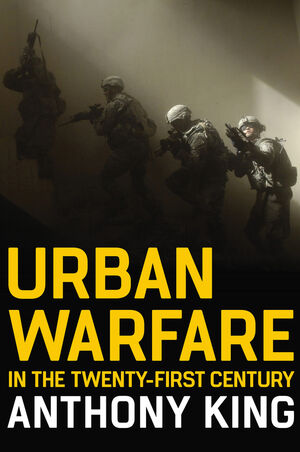It seems to be a constant theme that Clausewitz’s statement that “the character of warfare is constantly changing but its nature is eternal”. This theme is even more relevant in contemporary warfare due to increasing change in urban warfare environments. Urban Warfare in the Twenty-First Century written by Anthony King emphasises the dynamics of urban warfare and uses examples to show the changes from 1900 until now and into the future. It characterises the vast considerations which military professionals and soldiers will have to account for in the urban context. These are increasing in the twenty-first century and will only continue to do so. Anthony King splits this book into chapters based on different urban considerations. The use of diagrams and maps throughout the chapters allow for an increased awareness of context and understanding of concepts which is beneficial to readers.
At a glance, Urban Warfare in the Twenty-First Century enables readers to consider urban warfare from a more strategic perspective whilst still balancing the challenges ground forces face. I personally appreciated the bigger picture strategic perspective and arguments that King presents which are briefly summarised below. Two key ones that stood out for me were numbers and metropolis.
‘Numbers’ was one of the first chapters and gave a logical and statistical approach to the urban environment. One of the key points I took away from this is the disparity between militaries decreasing personnel and overall capability size and the requirement for more personnel in urban environments due to the increased complexity in operations.This is a major consideration for the ADF especially as the ADF is already a relatively small military and the increased demand for capability due to the changing warfare environment is going to stretch the current capabilities. So while, this is not accounting for other factors which influence capability such as technology, it is important to note and King has expressed this concern. Urban warfare has ultimately evolved through the military size decrease as now the battles which once were localised and formed a smaller part of a larger scale operation have now morphed into ‘bite and hold operations’ as King identifies them.
Furthermore, ‘metropolis’ highlights the increasing measure of cities in all facets including size, topography (vertically and horizontally), globalisation of cities, and organisational flow. As this took more of a geographical and demographic look at the civilian developments of population growth, density and construction, it was useful to consider as these are drastically changing compared to the warfare environment of the 19th and 20th centuries. This is vital when looking at urban warfare as operations will inevitably be unsuccessful without knowledge of the city. King argues that this knowledge is only going to need to be deeper and more accurate as urban warfare develops. The most interesting for me was organisational flow and examining a city’s makeup through business organisational charts adapted for the warfare context. This was definitely a new approach to looking at the construction of a city in the warfare environment context and provides interesting insights which are worth considering.
I personally liked how King ended the book with the chapter titled ‘Armageddon’ exploring the future environment and challenges of urban warfare. This chapter examines the potential warfare developments which may occur between now and 2040. These are widely written about by other scholars and King explores the implications of urban warfare from the perspective of these trajectories: megacity warfare, autonomised urban warfare and nuclear. This chapter for me was the most revealing and confronting in its portrayal of very realistic potential outcomes urban warfare holds. This extends from analysing counterinsurgency operations into the future developments of those. For anyone interested in the overall future of warfare and urban warfare’s place within that picture, this book gives the historical context before exploring these future challenges and is a must-read.
In conclusion, reading this book gave me a beneficial strategic insight into ground level operations and the increase in challenges, due to the urban warfare shift. King is very logical in his presentation of his arguments and perspective, especially when considering the future. I believe that Urban Warfare in the Twenty-First Century is a must read for any serving military member, regardless of service, as foundational knowledge of urban warfare in an increasingly joint force will be highly beneficial, if not already required. Anthony King gives this in a concise, well-constructed and easily understood manner. Not only could this be useful for serving members but also analysts and those observing military conflicts and overarching politics and strategy as well.
About the Author: Lauren Hutchinson is a second year RAAF Personnel Capability Officer, Officer Cadet at the Australian Defence Force Academy, studying a Bachelor of Business.

